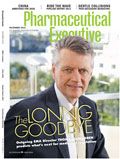In Through the Out Door
The end of anther year is an appropriate time to highlight the march of time-and the transitions that accompany it
The end of another year is an appropriate time to highlight the march of time—and the transitions that accompany it. This broad theme of passage helps bind our editorial offerings this month, in which we present the valedictory musings of one of the world's leading drug regulators as well as our annual update on the state of circulation in pharma's drug pipeline. We round things off with a profile of key market trends in China. The country too big to ignore is entering an era of flux as the government struggles to finance universal healthcare coverage while carving out a stake as a global player in life sciences innovation.

William Looney
Pharm Exec is written for top managers in the "C suite," where the ability to drive large group performance is a fundamental part of the job description. Hence why the profile of outgoing Executive Director of the European Medicines Agency, Thomas Lonngren, is a useful lesson in proving that, despite all the negatives imposed by the politicization of science, one person can still shape the culture of an entire organization.
Hubris is not associated with the Nordic model of governance, so Lonngren's background as a Swedish regulator was well suited for a time when the Agency had a shaky hold on power. Gradually, however, by pursuing an approach that married dour certitude and technical competence with an awareness of the densely layered politics behind European integration, Lonngren has been able to create what is today a world-class regulator—one that many drug companies now prefer to the FDA.
Lonngren is probably leaving at the right time. His successor is going to have to face a more assertive European Parliament as well as fresh concerns among the 27 member countries that European patients are not getting a fair deal under the centralized approval process because of sharp country-to-country variances in drug prices and level of access. Involvement of the Agency in this debate is not going to be a reputation enhancer. As Pharm Exec columnist Ansis Helmanis put it recently, "the next few years will determine to what extent those who hold the public purse strings will dictate priorities as to new drug development, clinical trial design, conditions for market approval, and patient access to new therapies. A perfect storm is brewing—and industry, patients, and the regulator should prepare for the sea change."
Our second feature, the annual tour d'horizon on new drugs in development, reveals another, perhaps more positive, transition is under way, with prospects progressing for the approval of medicines that promise real gains in the standard of care. The survey shows there is still life left in the blockbuster model and that discoveries linked to mapping of the human genome may finally be bearing fruit in the form of commercially viable drug candidates.
Finally, Pharm Exec's third installment in its series on the expanding Chinese pharmaceutical market documents a heady mix of opportunities and challenges facing both foreign-based and domestic firms. What is clear is that the pricing premiums foreign companies long enjoyed due to the link to product quality and originator innovation are being targeted. That's one way to help defray the associated costs of universal health coverage, but it also puts China in the forefront of a larger trend—the growing ability of emerging market governments to apply Western cost containment tools to limit investor returns from drugs sales. With government intervention to milk the industry on the rise, are the emerging markets still the industry's golden calf?
William Looney
Editor-in-Chief

Trump: 'Major Tariff' on Pharmaceuticals Coming Soon
Published: April 9th 2025 | Updated: April 9th 2025“We’re going to tariff our pharmaceuticals, and once we do that, they are going to come rushing back into our country," President Donald J. Trump said during a Tuesday night dinner in Washington.